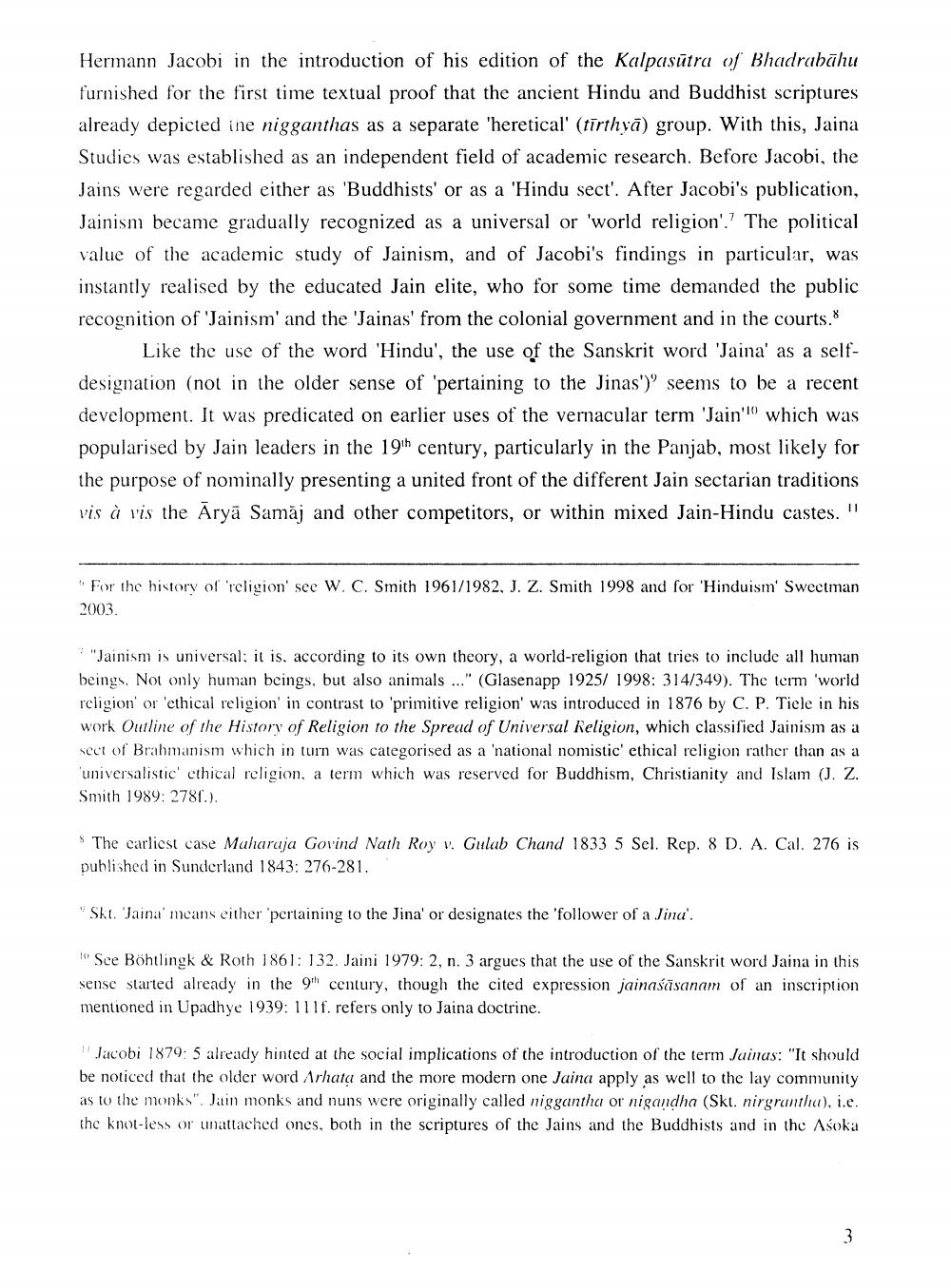________________
Hermann Jacobi in the introduction of his edition of the Kalpasūtra of Bhadrabahu furnished for the first time textual proof that the ancient Hindu and Buddhist scriptures already depicted ine nigganthas as a separate 'heretical' (tirthya) group. With this, Jaina Studies was established as an independent field of academic research. Before Jacobi, the Jains were regarded either as 'Buddhists' or as a 'Hindu sect'. After Jacobi's publication, Jainism became gradually recognized as a universal or 'world religion'.' The political value of the academic study of Jainism, and of Jacobi's findings in particular, was instantly realised by the educated Jain elite, who for some time demanded the public recognition of 'Jainism' and the 'Jainas' from the colonial government and in the courts."
Like the use of the word 'Hindu', the use of the Sanskrit word 'Jaina' as a selfdesignation (not in the older sense of 'pertaining to the Jinas")" seems to be a recent development. It was predicated on earlier uses of the vemacular term 'Jain'" which was popularised by Jain leaders in the 19th century, particularly in the Panjab, most likely for the purpose of nominally presenting a united front of the different Jain sectarian traditions vis à vis the Arya Samaj and other competitors, or within mixed Jain-Hindu castes.
11
"For the history of 'religion' see W. C. Smith 1961/1982, J. Z. Smith 1998 and for 'Hinduism' Sweetman 2003.
"Jainism is universal; it is. according to its own theory, a world-religion that tries to include all human beings. Not only human beings, but also animals ..." (Glasenapp 1925/ 1998: 314/349). The term 'world religion' or 'ethical religion' in contrast to 'primitive religion' was introduced in 1876 by C. P. Tiele in his work Outline of the History of Religion to the Spread of Universal Religion, which classified Jainism as a sect of Brahmanism which in turn was categorised as a 'national nomistic' ethical religion rather than as a 'universalistic' ethical religion, a term which was reserved for Buddhism, Christianity and Islam (J. Z. Smith 1989: 2781.).
The earliest case Maharaja Govind Nath Roy v. Gulab Chand 1833 5 Sel. Rep. 8 D. A. Cal. 276 is published in Sunderland 1843: 276-281.
Skt. Jaina' means either 'pertaining to the Jina' or designates the 'follower of a Jina'.
'See Böhtlingk & Roth 1861: 132. Jaini 1979: 2, n. 3 argues that the use of the Sanskrit word Jaina in this sense started already in the 9th century, though the cited expression jainasasanam of an inscription mentioned in Upadhye 1939: 111f. refers only to Jaina doctrine.
41
Jacobi 1879: 5 already hinted at the social implications of the introduction of the term Jainas: "It should be noticed that the older word Arhata and the more modern one Jaina apply as well to the lay community as to the monks". Jain monks and nuns were originally called niggantha or nigandha (Skt. nirgrantha), i.e. the knot-less or unattached ones, both in the scriptures of the Jains and the Buddhists and in the Aśoka
3




